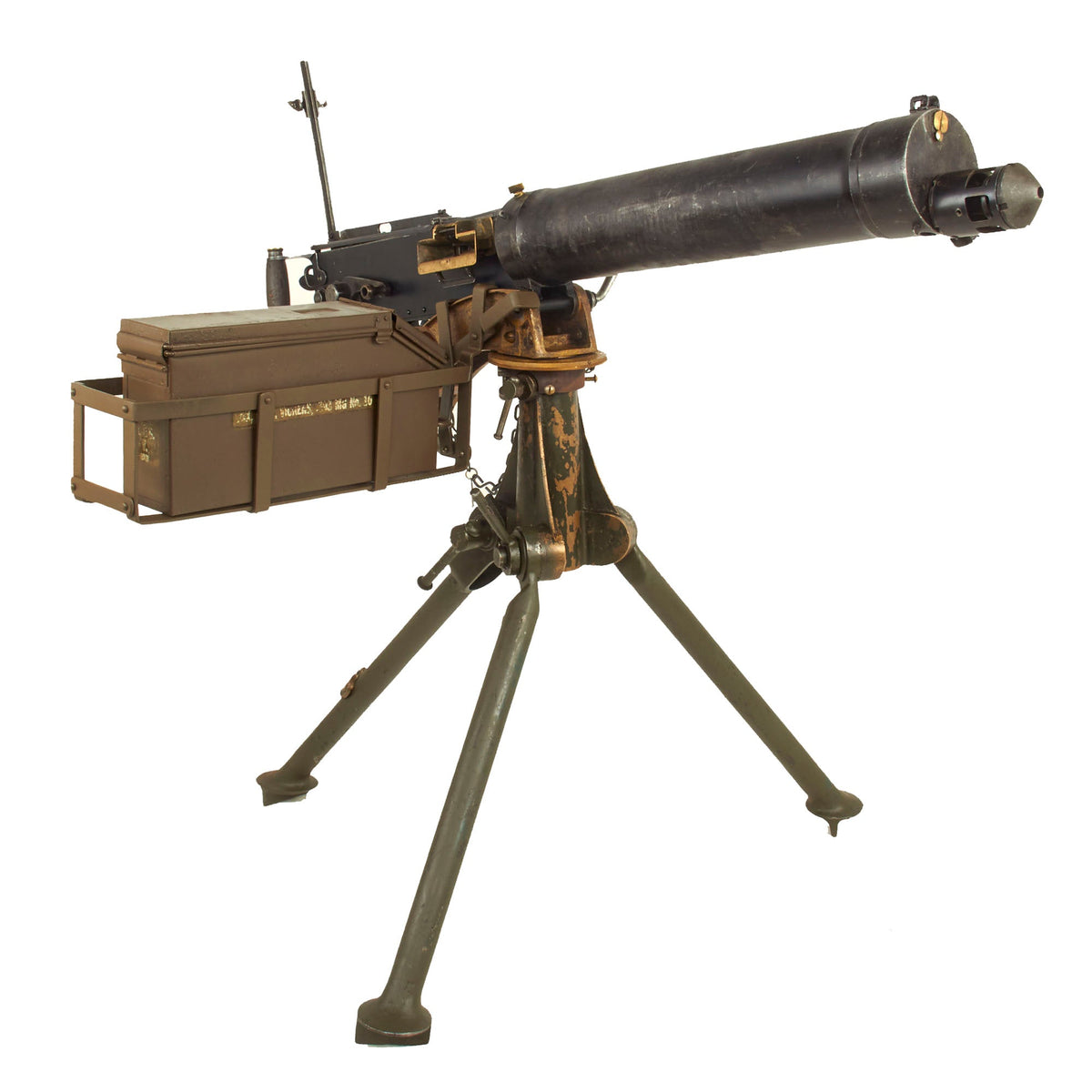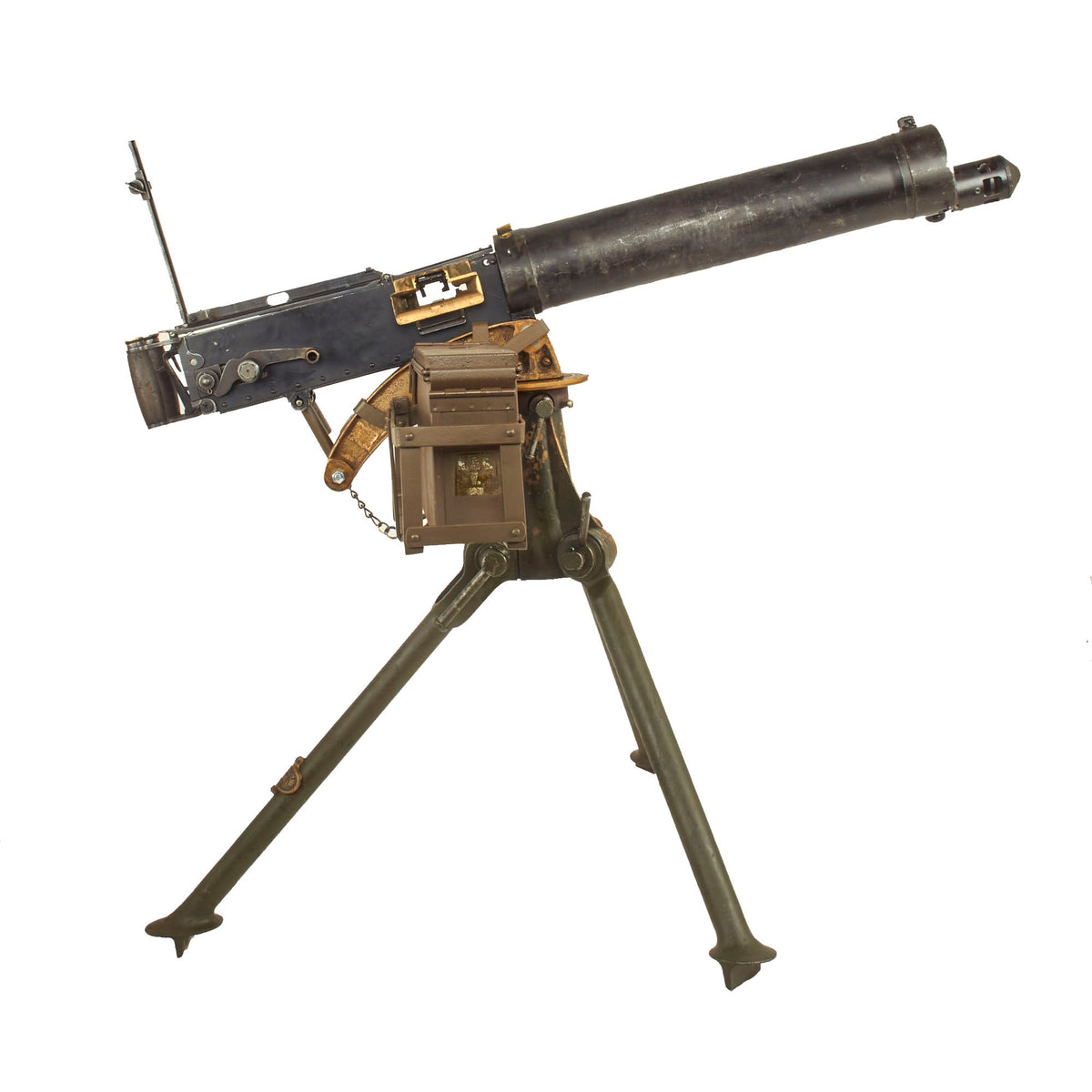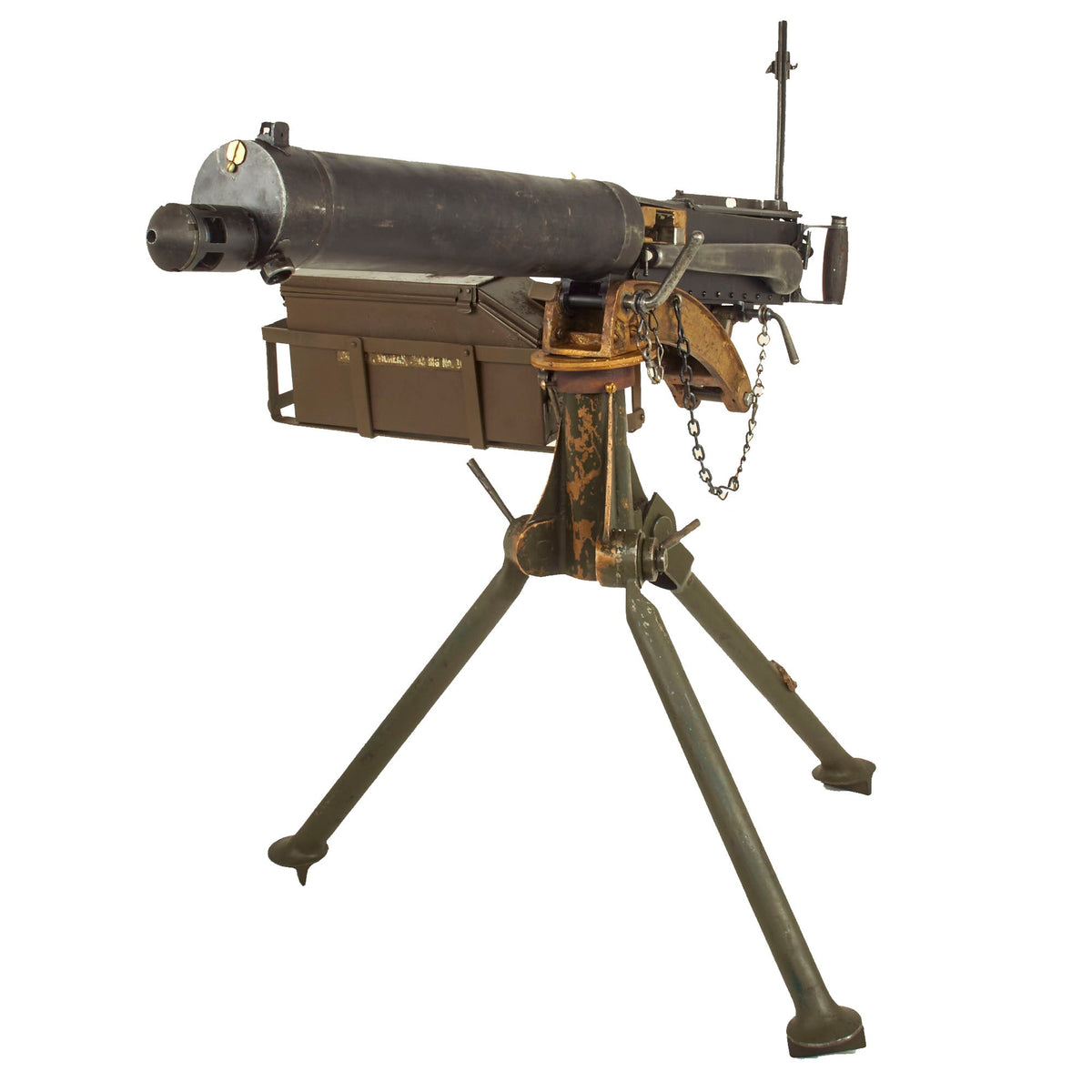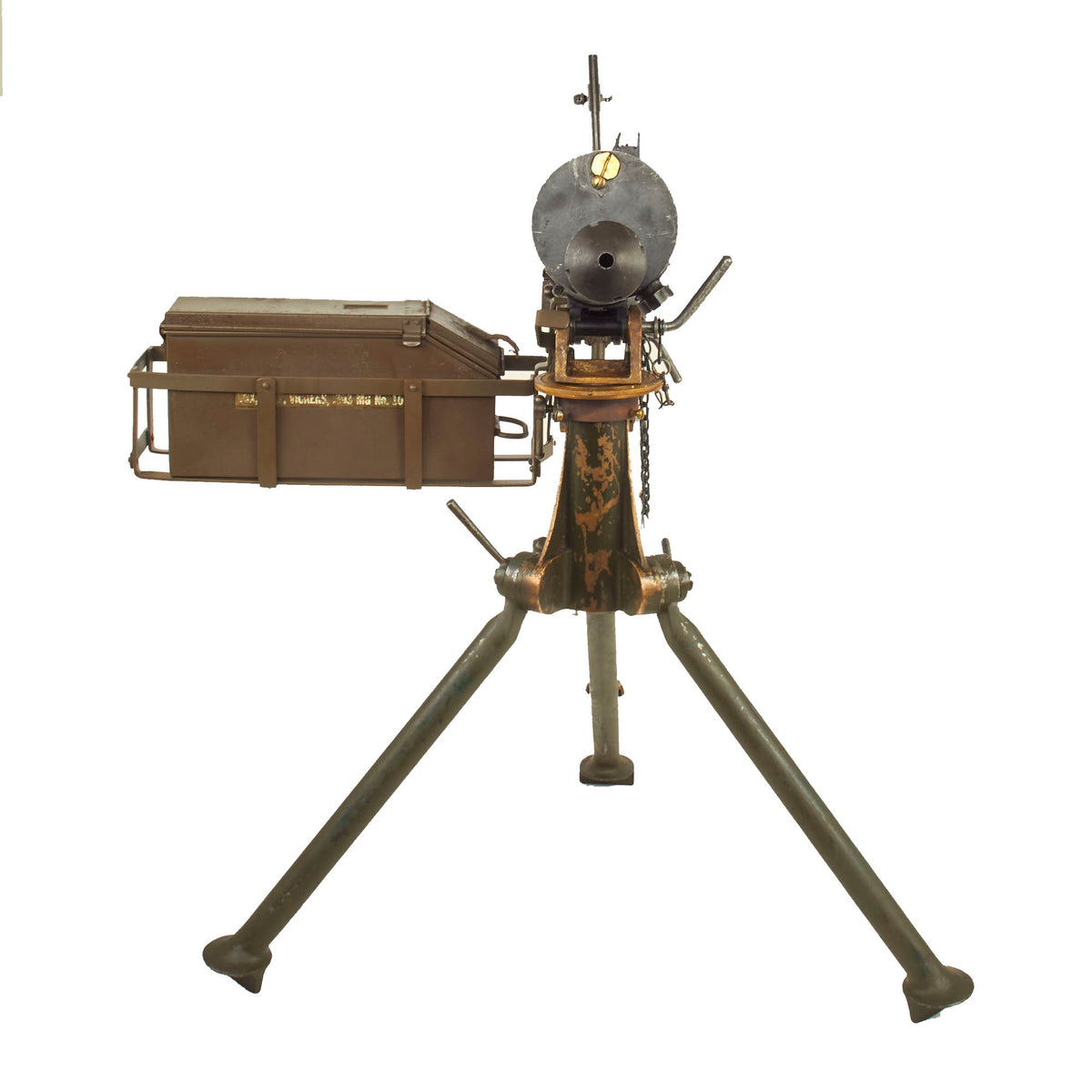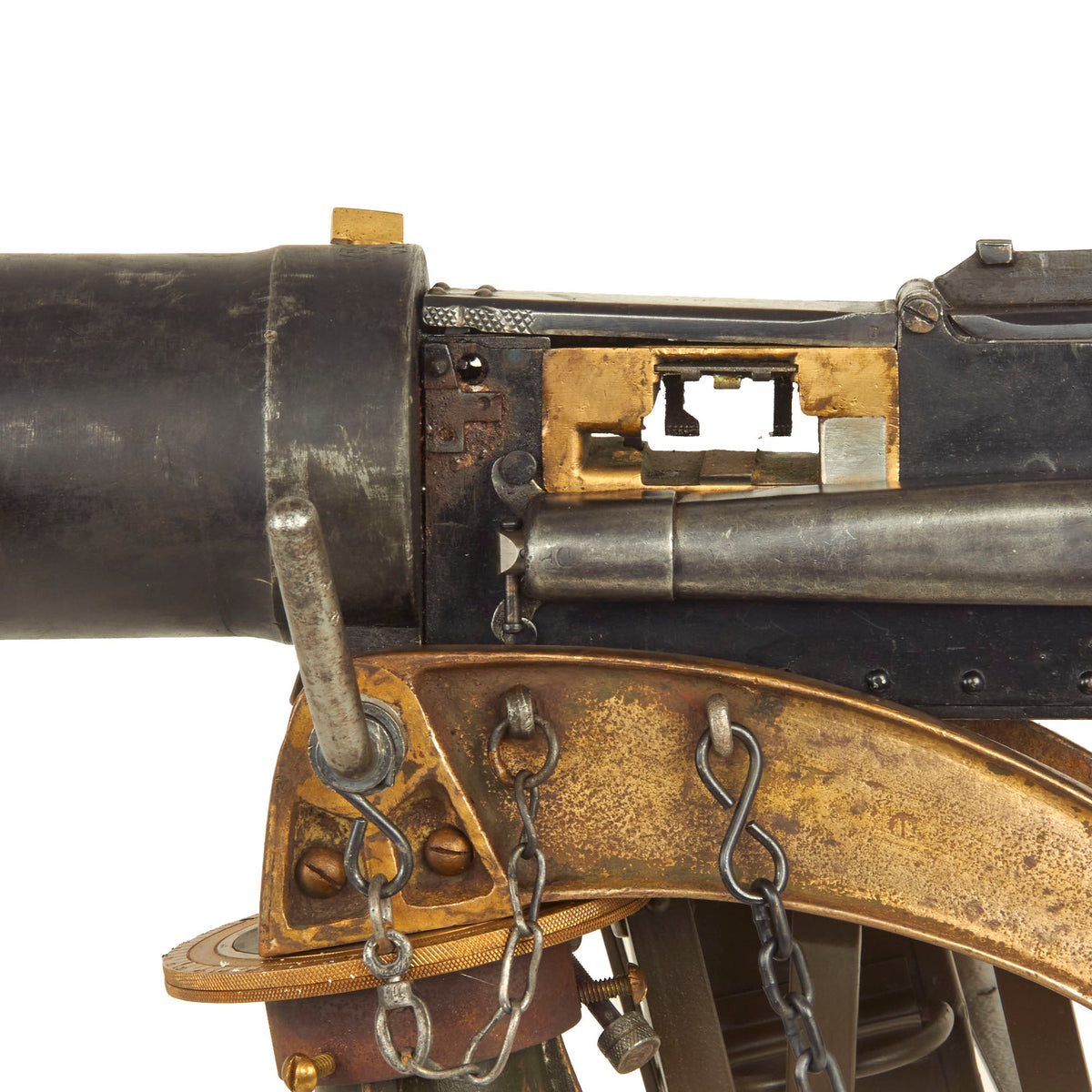Original British WWII Vickers Display Medium Machine Gun with 1930 Dated Portuguese Tripod & Accessories Original Items
$ 3.895,00 $ 973,75
Original Item: Only One Available. This a very nice condition WWII manufactured smooth water jacket Vickers display non-firing Medium Machine Gun, complete with multiple accessories and an original tripod. Constructed with new made, BATF compliant non-firing, steel dummy receiver right side plate incorporating most of the internal moving parts this “non-gun” is totally legal to own without any federal restrictions as it is no longer legally considered a firearm.
The gun is complete with a Portuguese made tripod with a data plate reading FÁBRICA DE BRAÇO DE PRATA on the top, with serial number N20 in the middle and a 1930 date on the bottom. This was a Portuguese government arsenal that purchased surplus tooling from Vickers in England to make their own Vickers in the 1930s. The tripod is fitted with a British brass crosshead which has some great markings on the top: M. T. 303. M. G. MK. IV, which is the tripod designation, and J. 39. REG. N. 908, which looks to be a regimental marking! It is however missing the elevation mechanism, which were often removed. We have added a custom fabricated spacer in its place so that the gun displays well.
These have become EXTREMELY scarce recently, especially complete original tripods. Many more parts sets were imported than tripods, and they are highly sought after. This is the first example we have had in some time that is mostly complete and totally correct, except for the tripod elevation mechanism mentioned previously. The only missing parts are a few small pins, such as the front top cover latch pin on the receiver. The display gun and tripod also come with an ammo can and one of our reproduction ammo can carriers to complete the look.
The Vickers machine gun or Vickers gun is a name primarily used to refer to the water-cooled .303 inch (7.7 mm) machine gun produced by Vickers Limited, originally for the British Army. The machine gun typically required a six to eight-man team to operate: one to fire, one to feed the ammunition, the rest to help carry the weapon, its ammunition and spare parts. It was in service from before the First World War until the 1960s.
The weapon had a reputation for great solidity and reliability. Ian V. Hogg, in Weapons & War Machines, describes an action that took place in August 1916, during which the British Army’s 100th Company of the Machine Gun Corps fired their ten Vickers guns continuously for twelve hours. Using 100 new barrels, they fired a million rounds without a single breakdown. “It was this absolute foolproof reliability which endeared the Vickers to every British soldier who ever fired one.”
The Vickers machine gun was based on the successful Maxim gun of the late 19th century. After purchasing the Maxim company outright in 1896, Vickers took the design of the Maxim gun and improved it, reducing its weight by lightening and simplifying the action and substituting components made with high strength alloys. A muzzle booster was also added.
The British Army formally adopted the Vickers gun as its standard machine gun on 26 November 1912, using it alongside their Maxims. There were still great shortages when the First World War began, and the British Expeditionary Force was still equipped with Maxims when sent to France in 1914. Vickers was, in fact, threatened with prosecution for war profiteering, due to the exorbitant price it was demanding for each gun. As a result, the price was slashed. As the war progressed, and numbers increased, it became the British Army’s primary machine gun, and served on all fronts during the conflict. When the Lewis Gun was adopted as a light machine gun and issued to infantry units, the Vickers guns were redefined as heavy machine guns, withdrawn from infantry units, and grouped in the hands of the new Machine Gun Corps.
After the First World War, the Machine Gun Corps (MGC) was disbanded and the Vickers returned to infantry units. Before the Second World War, there were plans to replace the Vickers gun; one of the contenders was the 7.92 mm (.312 in) Besa machine gun (a Czech design), which eventually became the British Army’s standard tank-mounted machine gun. However, the Vickers remained in service with the British Army until 30 March 1968. Its last operational use was in the Radfan during the Aden Emergency.
Fast Shipping with Professional Packaging
Thanks to our longstanding association with UPS FedEx DHL, and other major international carriers, we are able to provide a range of shipping options. Our warehouse staff is expertly trained and will wrap your products according to our exact and precise specifications. Prior to shipping, your goods will be thoroughly examined and securely secured. We ship to thousands clients each day across multiple countries. This shows how we're dedicated to be the largest retailer on the internet. Warehouses and distribution centres can be located throughout Europe as well as the USA.
Note: Orders with more than one item will be assigned a processing date depending on the item.
Before shipping before shipping, we'll conduct a thorough inspection of the items you have ordered. Today, the majority of orders will be delivered within 48 hours. The delivery time will be between 3-7 days.
Returns
The stock is dynamic and we cannot completely manage it because multiple stakeholders are involved, including our factory and warehouse. So the actual stock may alter at any time. It's possible that you may not receive your order once the order has been made.
Our policy is valid for a period of 30 days. If you don't receive the product within 30 days, we are not able to issue a refund or an exchange.
You can only return an item if it is unused and in the same state as the day you received it. You must have the item in its original packaging.
Related products
Uncategorized
Uncategorized
Uncategorized
Uncategorized
Uncategorized
Uncategorized
Uncategorized
Uncategorized
Uncategorized
Uncategorized
Uncategorized
Uncategorized
Uncategorized
Uncategorized
Uncategorized
Uncategorized
Uncategorized
Uncategorized
Armoured Fighting Vehicles of the World: AFVs of World War One (Hardcover Book) New Made Items
